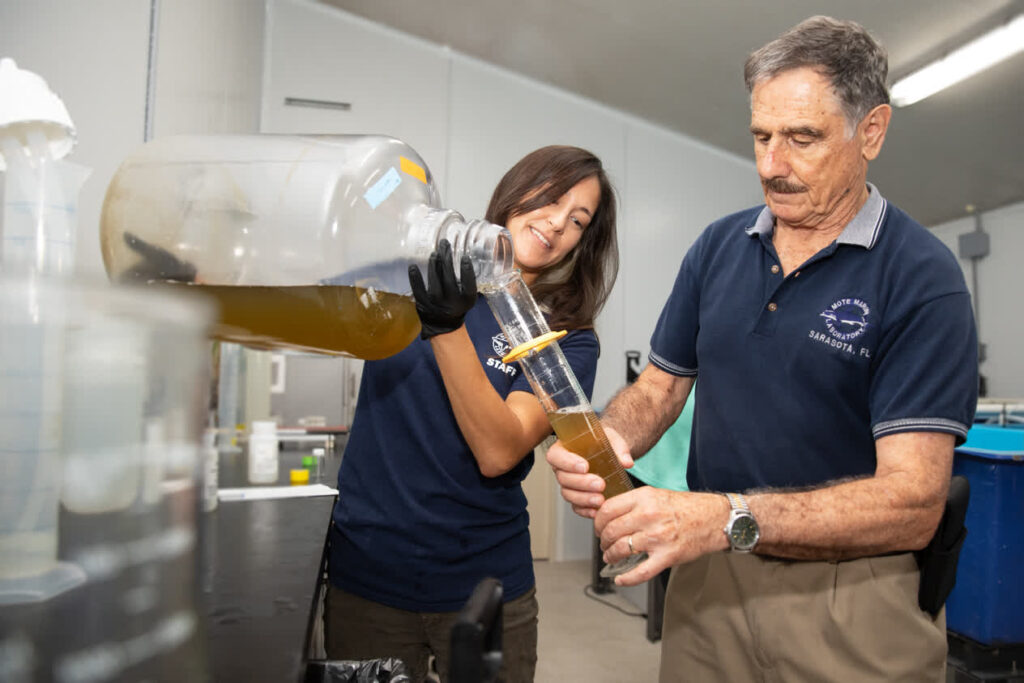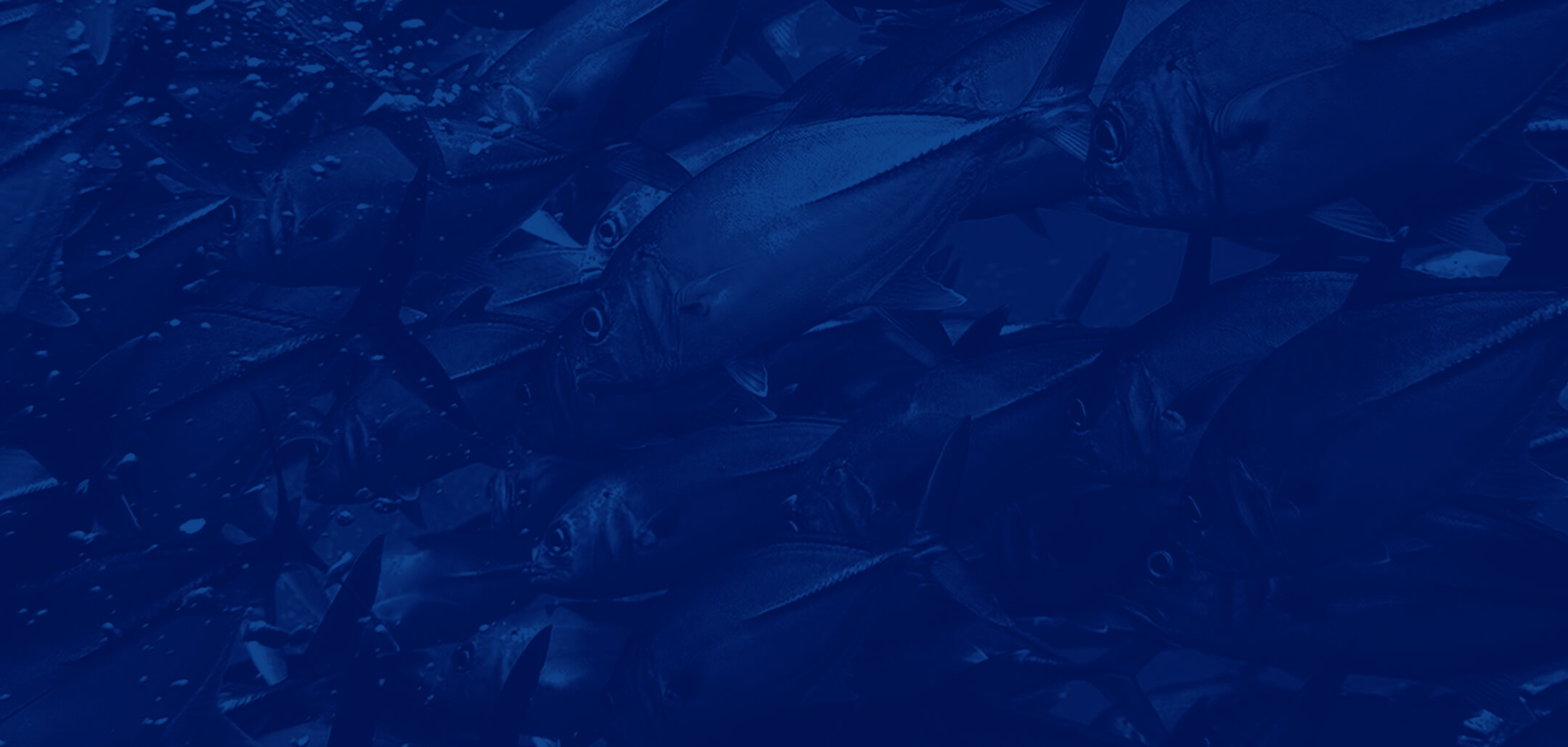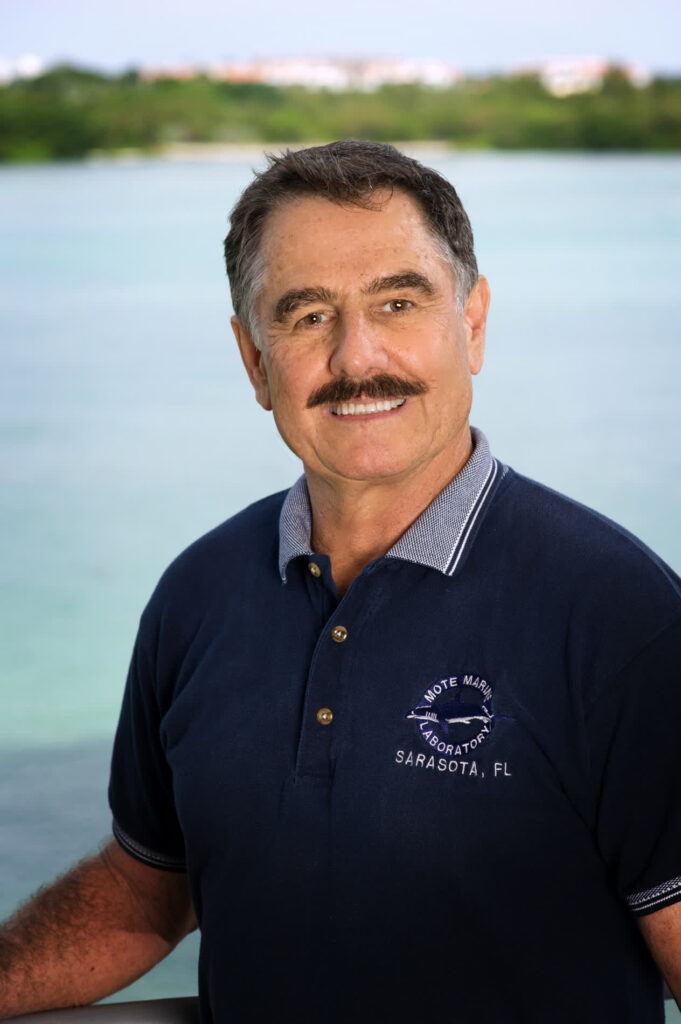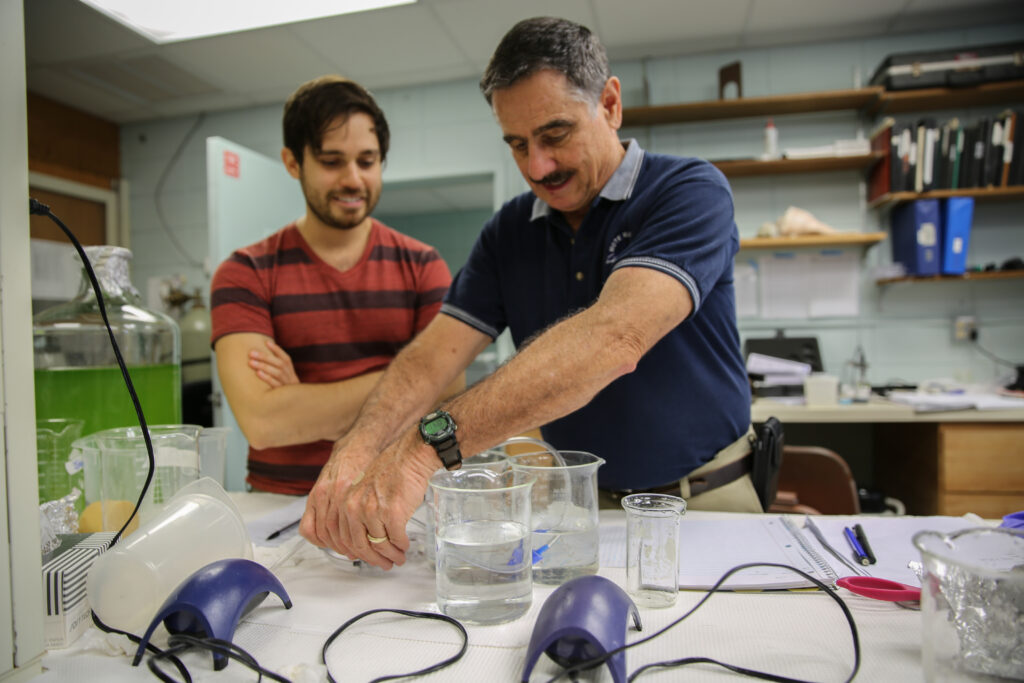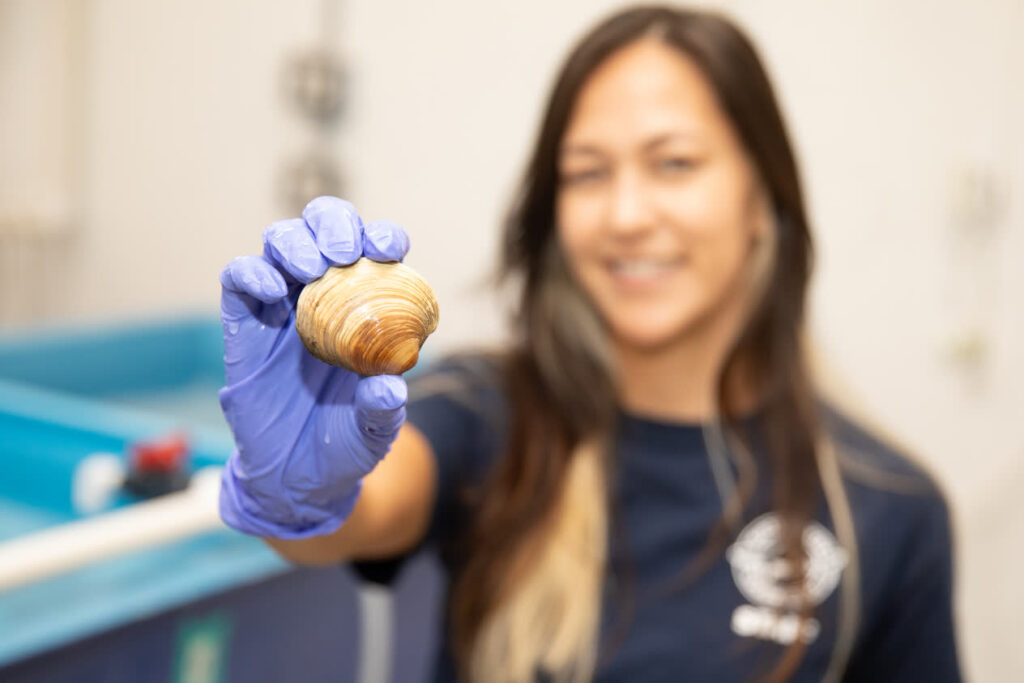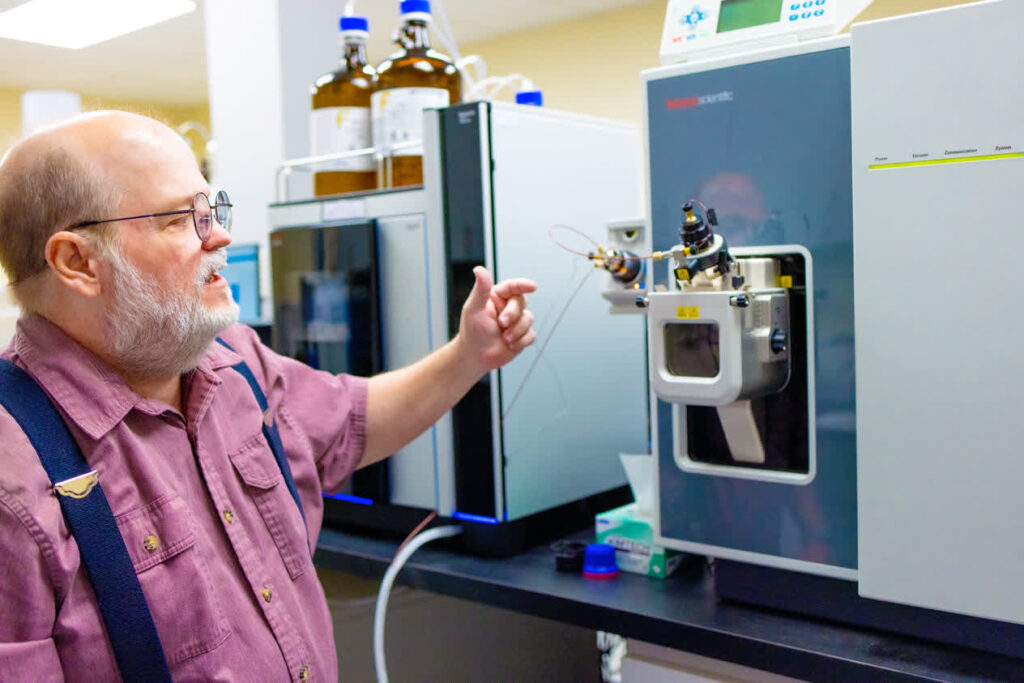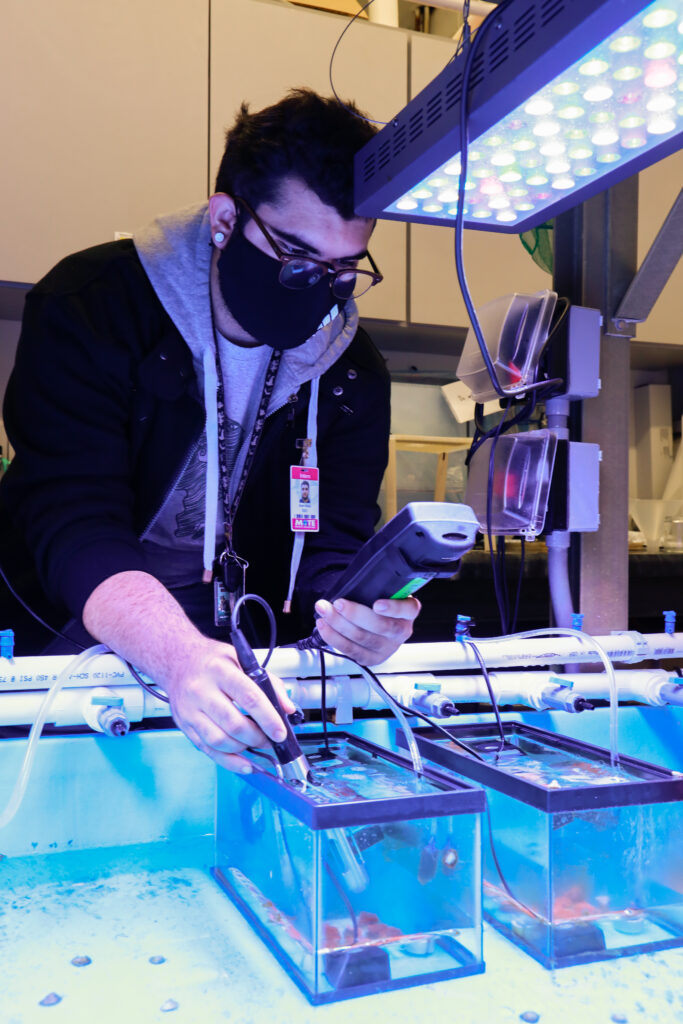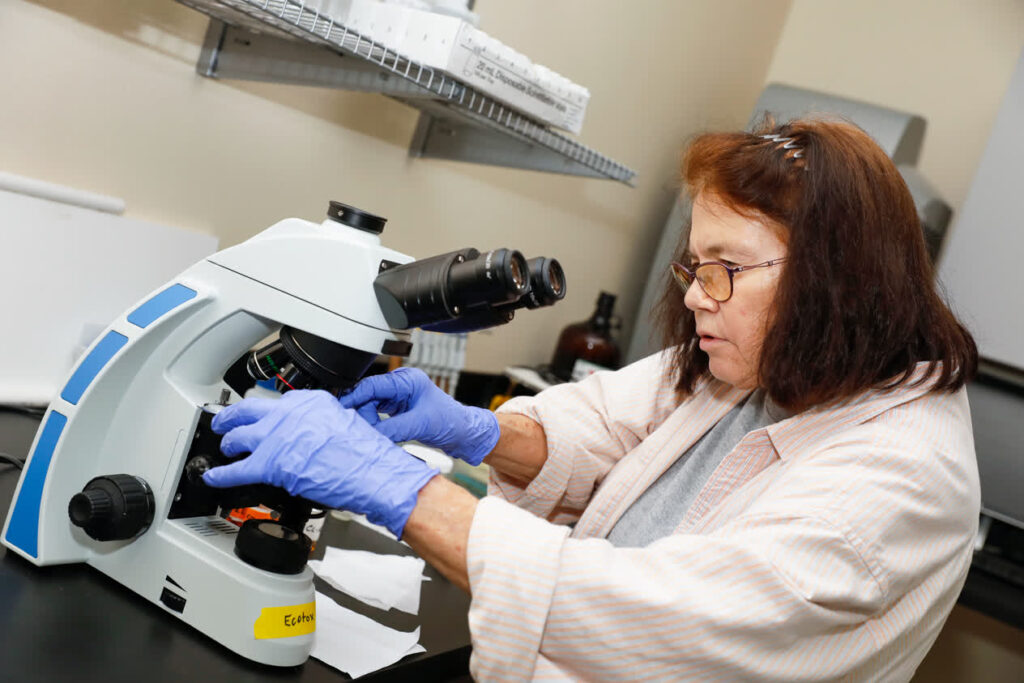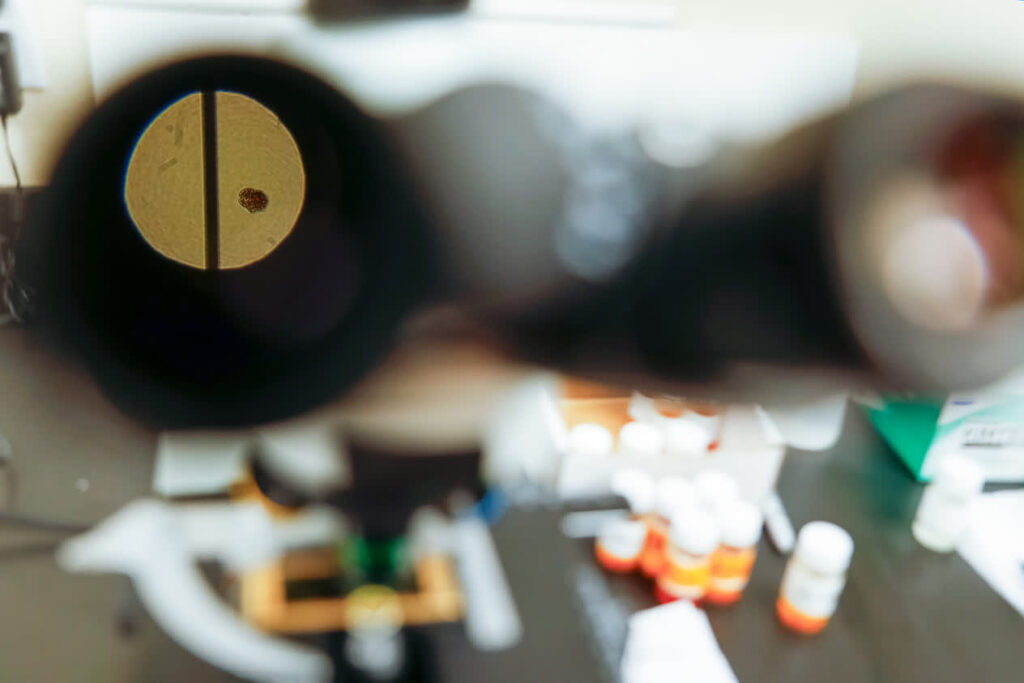The mission of the Ecotoxicology Research Program is to investigate the source, fate and effects of toxic substances in the environment, including natural biotoxins (harmful algal toxins) and chemical pollutants (pesticides, petroleum, industrial contaminants, pharmaceuticals). To develop and implement new technologies for identification and monitoring toxic substances, to assess impacts from exposure to living natural resources and to work with federal, state and local stakeholders to identify ways to reduce ecological risks while protecting public health and enhancing Florida’s economy.
Program Details
Current Projects
- Assess the Effects of Mosquito Control Pesticides on Non-Targeted Organisms in the Florida Keys National Marine Sanctuary; PI; R. Pierce: EPA-WQPP; 1/12 to 9/14, with FL Keys Mosquito Control Dist.; FL FWC/FWRI; Levi Foundation. Monitoring the distribution of mosquito control pesticides in the Fl Keys National Marine Sanctuary and using the expected environmental concentrations to assess the impact on coral and lobster larvae as sentinel non-targeted organisms.
- Reduction of Harmful Impacts from Florida Red tide: Fate and Effects of Brevetoxins: PI R. Pierce, Cooperative program with FL FWC/FWRI,. 7/12 to 6/15: Investigating the occurrence, persistence and adverse effects of red tide neurotoxins in water, air and marine organisms.
- Synergistic Effects of Ocean Acidification with Mosquito Control Pesticides and Pharmaceuticals on Coral Reproduction and Recruitment. P.I. R. Pierce; FL Protect our Reefs; 5/13 to 4/14.: Investigating how climate change impacts the toxicity of toxic chemicals on coral larvae.
- Phytoestrogen Analysis in Estuarine Water. P.I. R. Pierce US Geological Survey, 9/13 to 3/14. Investigating the presence of natural and anthropogenic estrogens in coastal waters.
- The Impact of Elevated Temperature and Mosquito Control Pesticides on Coral Larvae Physiology and Settlement:, PI C. Ross, UNF; Co-PI, R. Pierce. 3/14 to 3/15.
- Determine the Distribution and Persistence of Mosquito Control Pesticides in the National Key Deer Refuge, Big Pine Key, FL. PI, T. Bargar, USGS, Co-PI, R. Pierce, 3/14 to 3/15. Investigate the distribution, persistence and effects on non-targetred organisms in the NKDR.
Grants Received
- US Environmental Protection Agency, FKNMS WQPP: Impact of Mosquito Control pesticides on non-targeted organisms in the FL Keys National Marine Sanctuary. 2013 -2015
- FWC/FWRI; Cooperative red tide research program: Fate and effects of red tide neurotoxins; 2012 to 2015.
- US Geological Survey: Phytoestrogens in coastal waters. 2013-14.
- USGS: Distribution, persistence and impact of mosquito control pesticides on non-targeted organisms in the FL Keys National Key Deer Refuge. 2014 to 2015.
- FL Dept, of Agriculture and Consumer Services: Effects of pesticide-contaminated food particles on toxicity of pesticides in the marine environment. 2014 to 2015.
Research Collaborations
- US. EPA, Florida Keys National Marine Sanctuary Water Quality Protection Program; Dr. Steven Blackburn
- US Geological Survey; Dr. Tim Bargar
- US Fish and Wildlife Service; Dr. Robert Frakes, Dr. Anthony Sowers
- Florida Keys National Key Deer Refuge, DOI; Director Ann Morkill
- Florida Keys Mosquito Control, District; Director Michael Dolye, Ms. Andrea Leal
- FL FWC/FWRI; Dr. Leanne Flewelling, Dr. Alina Corcrin, Dr. Thomas Matthews, Ms Gabriella Renchen
- Woods Hole Oceanographic Institute; Dr. Don Anderson
- University North Carolina, Wilmington; Dr. Daniel Baden
- Florida Gulf Coast University; Dr. Aswani Volety
- Florida International University.; Dr. Gary Rand
- University of North Florida; Dr. Cliff Ross
- Smithsonian Marine Satation; Dr. Valerie Paul
Proud Partners in the Red Tide Initiative
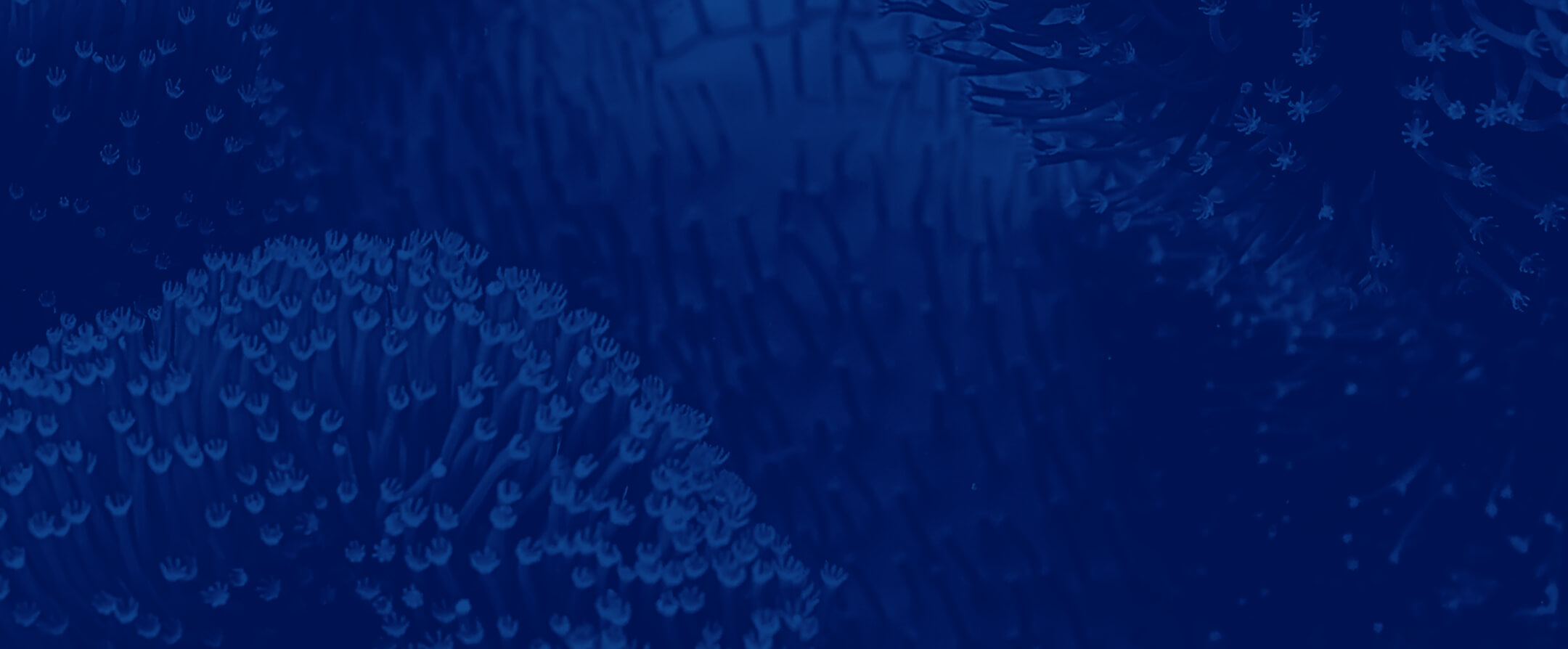
Additional Program Information
- 2012 Bricelj, V. M., A-G. Haubois, M. R. Sengco, R.H. Pierce, J. K. Culter, D. M. Anderson. Trophic transfer of brevetoxins to the benthic macrofaunal community during a bloom of the harmful dinoflagellate Karenia brevis in Sarasota Bay, Florida. Harmful Algae, 16, 27-34.
- 2011 Pierce, R. H., M. S. Henry, P. C. Blum, S. E. Osborn, Y. S. Cheng, Y. Zhou, and C. M. Irvin, A. J. Bourdelais, J. Naar, D.G. Baden. Compositional changes in neurotoxins and their oxidative derivatives from the dinoflagellate, Karenia brevis, in seawater and marine aerosol. Jour. Plankton Research, 33 ( 2) p 343-347.
- 2011 Kirkpatrick, B., L. E. Fleming, J. A. Bean, K. Nierenberg, L. C. Backer, Y-S. Cheng, R. H. Pierce, A. Reich, J. Naar, A. Warner, W. Abraham, Y. Zhou, J. Hollenbeck and D. G. Baden. Aerosolized red tide toxins (brevetoxins) and asthma: Continued health effects after 1 hour beach exposure. Harmful Algae. 10:138-143.
- 2011 Roelke, D. L., and R. H. Pierce. Effects of inflow on harmful algal blooms: Some considerations. J. Plankton Res. 33: 205-209.
- 2010 Cheng, Y. S., Y. Zhou, C. M. Irvin, R. H. Pierce, M. S. Henry, D. G. Baden, Chracterization of Florida red tide aerosol and the temporary profile of aerosol concentration, Toxicon., 55, 922-929.
- 2010 Cheng, Y-S, Y. Zhue; J. Naar; C. M. Irvin; W-C. Su; L. E. Fleming; B. Kirkpatrick; R. H. Pierce; L.C. Backer; D. G. Baden. Personal exposure to aerosolized red tide toxins (brevetoxins). J. Occupant. & Environ. Hygiene, 7(6):326-31.
- 2010 Kirkpatrick, B., R. H. Pierce, Y. S. Cheng, M. S. Henry, P. C. Bluma, S. Osborn, K. Nierenberga, B. A. Pederson, L. E. Fleming, A. Reich, J. Naar, G. Kirkpatrick, L. C. Backer, D. G. Baden. 2009. Inland Transport of Aerosolized Florida Red Tide Toxins, Harmful Algae, 9 (2), p.186-189
- 2010; Ross, C., R. Ritson-Williams, R. Pierce, M. Henry, J. Bullington, V. Paul., Effects of the Florida red tide dinoflagellate, Karenia brevis, on oxidative stress metamorphosis of larvae of the coral, Porites astreodies. Harmful Algae, 9, p 173-179.
- 2009 Fleming,L., J. Bean, B. Kirkpatrick, Y-S. Cheng, R. Pierce, J. Naar, K. Nierenberg, L. Backer, A. Wanner, A. Reich, Y. Zhou, S. Watkins, M. Henry, J. Zaias, W. Abraham, J. Benson, A. Cassedy, J. Hollenbeck, G. Kirkpatrick, T. Clarke, and D. Baden. 2009, Exposure and Effect Assessment of Aerosolized Red Tide Toxins (Brevetoxins) and Asthma. Environmental Health Perspectives, 117 (7) p. 1095-1100.
- 2008 Fire, S.F., L. J. Flewelling, J. Naar, M.S. Henry, R. H. Pierce, D. P. Gannon, Z. Wang, L. Davidson, R. S. Wells. Prevalence of brevetoxins in prey fish of bottlenose dolphins in Sarasota Bay, FL. Marine Ecol Series, Mar. Ecol. Prog. Ser., 368, 283-294.
- 2008 Fire, S. F., L. J. Flewelling, J. Naar, M. S. Henry, R. H. Pierce, R. S. Wells. Florida red tide and brevetoxins: Association and exposure in live resident bottlenose dolphins (Tursipos truncates) in the eastern Gulf of Mexico. Mar. Mammal Sci., 24, 831-844.
- 2008. Pierce, R. H., and M. S. Henry. Harmful Algal Toxins of the Florida Red Tide (Karenia brevis): Natural Chemical Stressors in South Florida Coastal Ecosystems. Ecotoxicology. 17 (7) 623-631.
- 2008. Pierce, R. H., M. S. Henry and P. C. Blum. Brevetoxin abundance and composition during ECOHAB Florida field monitoring cruises in the Gulf of Mexico. Continental Shelf Research. 1(1) 45-58.
- 2008. Plakas, S. M., E. L. E. Jester, K. r. El Said, H. R. Granade, A. Abraham, R. W. Dickey, P. S. Scott, L. J. Flewelling, M. Henry, P. Blum and R. Pierce. Monitoring of Brevetoxins in the Karenia brevis Bloom-exposed Eastern Oyster (Crassostrea virginica). Toxicon, 52. 32-38.
- 2008. Walsh, C. J., S. R. Leggett, K. Strohbehn, R. H. Pierce and J. W. Sleasman. Effects of in vitro brevetoxin exposure on apoptosis and cellular metabolism in a leukemic T cell line (Jurkat). Marine Drugs 02/2008; 6(2):291-307. DOI:10.3390/md20080014.
- 2007 Fire, S. F., L. J. Flewelling, J. Naar, M. S. Henry, R. H. Pierce, R. S. Wells. Brevetoxin exposure in bottle nose dolphins (Tursiops truncates) associated with Karenia brevis blooms in Sarasota Bay, Florida. Mar. Biol. 152: 827-834.
- 2007 Fleming, L. E., B. Kirkjpatrick, L. C. Backer, R. H.Pierce, Et al. Aerosolized Red-Tide Toxins (Brevetoxins) and Asthma. Chest. 131: p. 187-194.
- 2007 Naar, J. L. J. Flewelling, A. Lenzi, J. P. Abbott, A. Granholm, H. Jackoks, D. Gannon, M. Henry, R. Pierve, D.G. Baden, J. Wolny and J. H. Landsberg. Berevetoxins, like ciguatoxins, are potent ichthyotoxic neurotoxins that accumulate in fish. Toxicon., 50: 707-723.
- 2007.Twiner M. J., M-Y Bottein-Dechraoui, Z. Wang, C. M. Mikulski, M. S. Henry, R. H. Pierce, G. J. Doucette. Extraction and analysis of lipophilic brevetoxins from the red tide dinoflagellate Karenia brevis. Analytical Biochemistry 369, 128–135.
- 2006. Pierce, R. H., M. S. Henry, P. C. Blum, S. M. Plakas, H. R. Granade, E. L. E. Jester, K. R. El Said, R. W. Dickey, K. A. Steidinger, P. S. Scott, L. J. Flewelling, J. L. C. Wright. Comparison of Methods for Determination of Brevetoxins and their Metabolites in NSP-Toxic Bivalved Molluscs. Proceedings of the 5th International Conference on Molluscan Shellfish Safety, Galway Ireland, June 14-18, 2004. (Edts. K. Henshilwood, B. Deegan, T. McMahon, C. Cusack, S. Keaveney, J. Silke, M. O’Cinneide, D. Lyons and P. Hess). The Marine Institute, Rinville, Oranmore, Galway, Ireland. p.37-42.
- 2006. Abraham, A., S. M. Plakas, Z. Wang, E. L. E. Jester, K. R. El Said, H. R. Granade, M. S. Henry, P. C. Blum, R. H. Pierce and R. W. Dickey, Characterization of Polar brevetoxin derivatives from Karenia brevis cultures and natural blooms. Toxicon, 48. 104-115.
- 2005 Cheng, Y-S., J. D. McDonald, D. Kracko, C. M. Irving, Y. Zhou, R. H. Pierce, M. S. Henry, A. Bourdelais, J. Naar and D. G. Baden. Concentration and particle size of airborne toxic algae (brevetoxin) derived from ocean red tide events. Environ. Sci Technol. 39, 3443-3449.
- 2005 Cheng, Y-S., Y. Zhou, C. M. Irving, R. H. Pierce, J. Naar, L. C. Backer, L. E. Fleming, B. Kirkpatrick and D. G. Baden, Characterization of marine aerosol for assessment of human exposure to brevetoxins. Environmental Health Perspectives, 113 (5), 638-643.
- 2005 Cheng, Y-S., T. A. Villareal, Y. Zhou, J. Gao, R. H. Pierve, D. Wetzel, J. Naar, D. G. Baden. Characterization of red tide aerosol on the Texas coast. Harmful Algae, 4, 87-94.
- 2005 Fleming, L. E., B. Kirkjpatrick, L. C. Backer, R. H.Pierce, Et al. Initial Evaluation of the Effects of Aerosolized Red Tide Toxins (Brevetoxins) in Peresons with Asthma. Env. Health Persp. 113(5): p. 650-657.
- 2005. Flewelling, L. J. P. Naar, J. P. Abbott, D. G. Baden, N. B. Barros, G. D. Bossart, M-Y. D. Bottein, D. G. Hammond, E. M. Haubold, C. A. Heil, M. S. Henry, H. M. Jacocks, T. A. Leighfield, R. H. Pierce, T. D. Pitchford, S. A. Rommel, P. S. Scott, K. A. Steidinger, E. W. Truby, F. M. Van Dolah, J. H. Landsberg. Red Tides and Marine Mammal Mortalities. Nature 435
- 2005. Pierce, R. H., M. S. Henry, P. C. Blum and E. M. Mueller. Aerial and Tidal Transport of Mosquito Control Pesticides into the Florida Keys National Marine Sanctuary. Inter. Jour. Tropical Biol. Conserv. 53: 117-125.
- 2005 Backer, L. C., Kirkpatrick, B., Fleming, L. E., Cheng, Y. S., Pierce, R., Beane, J. A., Clark R, Johnson D, Wanner A, Tamer R, Baden D. 2005. Occupational Exposure to Aerosolized Brevetoxins during Florida Red Tide Events: Effects on a Healthy Worker Population Environ Health Perspect: Vol. 113, p. 644- 650.2005.
- 2005 Pierce, R. H., M. S. Henry, P. C. Blum, S. L. Hamel, B. Kirkpatrick, Y. S. Cheng, Y. Zhou, C. M. Irvin, J. Naar, A. Weidner, L. E. Fleming, L. C. Backer, and D. G. Baden. Brevetoxin Composition in Water and Marine Aerosol along a Florida Beach: Assessing Potential Human Exposure to Marine Biotoxins. Harmful Algae. 4, pp. 965-972).
- 2004 Dickey, R. W., S. M. Plakas, R. H. Pierce, et al. Multi-Laboratory Study of Five Methods for the Determination of Brevetoxins in Shellfish Tissue Extracts. Steidinger, K. A., Landsberg, J. H., Tomas, C. R. and Vargo, G. A. (Eds.). FL. Fish and Wildlife Conserv. Comm. and International Oceanogr. Comm. of UNESCO,. Contrib. 715. p. 549-551.
- 2004 Fleming, L. E., L. C. Backer, R. H. Pierce, et al. An Epidemiological to Study of Aerosolized Florida Red Tides. Steidinger, K. A., Landsberg, J. H., Tomas, C. R. and Vargo, G. A. (Eds.). Fl. Fish and Wildlife Conserv. Comm. and International Oceanogr. Comm. of UNESCO,. Cont. Fl. Fish and Wildlife Conserv. Comm. and International Oceanogr. Comm. of UNESCO,. Contrib.667. p 508-510.
- 2004 Kirkpatrick, B., L. E. Fleming, D. Squicciarini, L. C. Backer, R. Clark, W. Abraham, J. Benson, Y-S Cheng, D. Johnson, R. Pierce, J. Zaias, G. D. Bossart and D. G. Baden. Literature review of Florida red tide: implications for human health effects. Harmful Algae, 3, 99-115. Harmful Algae, 2002.
- 2004 Pierce, R. H. and R. M. Dickey. Summary of Special Session on Detection and Quantitation of Toxins. Harmful Algae
- 2002. Steidinger, K. A., Landsberg, J. H., Tomas, C. R. and Vargo, G. A. (Eds.). Fl. Fish and Wildlife Conserv. Comm. and International Oceanogr. Comm. of UNESCO,. Contrib. 718. p. 549-551
- 2004 Pierce, R. H., M. S. Henry, R. Dickey and S. Plakas, NSP Toxins and metabolites in oysters, clams, and whelks. Harmful Algae 2002. Steidinger, K. A., Landsberg, J.H., Tomas, C. R. and Vargo, G. A. (Eds.). Fl. Fish and Wildlife Conserv. Comm. and International Oceanogr. Comm. of UNESCO, Cont. 716. p. 294-296.
- 2004 Pierce, R. H., M. S. Henry, C. J. Higham, P. C. Blum, M. R. Sengco and D. M. Anderson. Removal of harmful algal cells (Karenia brevis) and toxins from seawater culture by clay flocculation. Harmful Algae. 3, 141-148.
- 2004 Pierce, R. H., D. L. Wetzel, and E. D. Estevez. Charlotte Harbor Initiative: Assessing the Ecological Health of Southwest Florida’s Charlotte Harbor Estuary. Ecotox. 13, 274-284.
- 2004 Weidner, A. L., J. Naar, K. Steidinger, R. Pierce, M. Henry, L. Flewelling, D. G. Baden. Variability of Brevetoxin Accumulation Levels within Individual Shellfish during Karenis brevis Blooms. Steidinger, K.A., Landsberg, J. H., Tomas, C. R. and Vargo, G. A. (Eds.). Fl. Fish and Wildlife Conserv. Comm. and International Oceanogr. Comm. of UNESCO, Cont. 719. p. 485-487
- 2003 Schneider, K. R., R. H. Pierce and G. E. Rodrick, 2003. The degradation of Karenia brevis toxins utilizing ozonated seawater. Harmful Algae, 2. 101-107.
- 2003 Backer, L. C., L. E. Fleming, A. Rowan, Y-S. Cheng, J. Benson, R. H. Pierce J. Zias, J. Bean, G. D. Bossart, D. Johnson, R. Quimbo and D. G. Baden. 2003. Recreational exposure to aerosolized brevetoxins during FL red tide events. Harmful Algae, 2,19-28.
- 2003 Pierce, R. H, M. S. Henry, P. C. Blum, J. Lyons, Y. S. Cheng, D. Yazzie, and Y. Zhou. Brevetoxin Concentrations in Marine Aerosol: Human Exposure Levels During a Karenia brevis Harmful Algal Bloom. Bull. Environ. Contam. Toxicol., 70 (1), 161-165.
- 2003 Pierce, R. H. , M. S. Henry, J. Lyons, G. E. Rodrick, P. Aaronson, T. A. Leighfield, 2003. Comparison of red tide toxin reduction in clams using ozone purification and relay cleansing. In: Molluscan Shellfish Safety (Ed) A. Villalba, B. Reuera, J. L. Romalde and R. Beiras. Proceedings of the 4th International Conference on Molluscan Shellfish Safety, Santiago de Compostela, Spain, June 4 – 8, 2002. Conselleria de Pescae Asuntos Maritimos, Xunta de Galicia, IOC, UNESCO, p 145–150.
- 2001 Pierce, R. H. and G. J. Kirkpatrick. Innovative techniques for harmful algal toxin analysis. Environmental Toxicology and Chemistry 20(1): 107-114.
- 2001 Pierce, R. H., M. S. Henry, P. Blum, and S. Payne. Gymnodinium breve toxins without cells: Intra-cellular and extra-cellular toxins. In: G. M. Hallegraeff, S. I. Blackburn, C. J. Bolch, and R. J. Lewis (eds.), Harmful Algal Blooms 2000. IOC of UNESCO, Paris 2001. p. 421-424.
- 2000 R.H., M. S. Henry, D. Kelly and W. Kozlowski. Hazard Assessment of Temephos Applied to a Southwest Florida Saltmarsh Community. Journal of Environmental Toxicology and Chemistry 19(2):501-507.

